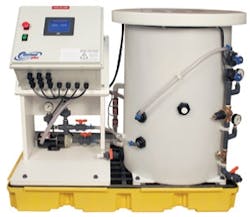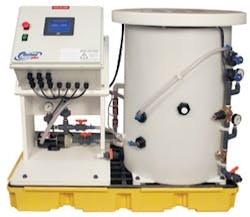Algae Based Treatment System Reduces Energy Costs
Oldcastle Precast, a manufacturer of precast and polymer concrete products, has signed an exclusive agreement with Indianapolis based Algaewheel Technologies LLC to sell Algaewheel technology as part of its wastewater treatment systems.
Oldcastle's new Maxpac™ Package Plant Wastewater System combines Algaewheel® technology - simple clarification processes enhanced by the natural coagulating effects of algae filaments - and disinfection to result in effluent treated to secondary and tertiary standards.
During the treatment process, algae produce oxygen to feed the bacteria, and bacteria produce CO2 to feed the algae, thus significantly reducing the carbon footprint. In the process, nutrients and BOD are removed from the waste stream. The packaged plant system is currently designed for use in smaller-scale decentralized wastewater treatment applications. A larger-capacity system is under development.
The Algaewheel technology was initially developed for use as an aquatic life support system in aquaculture systems. The wheel used in the process is designed to provide the proper environment for algal growth. Wave surging and light pulsing are basic environmental conditions required for algae growth and these are provided through the patented design.
The wheel is significantly buoyant in water, requires no mechanical drive mechanism, and is rotated using a constant air flow. Each wheel is supported in water using a modular plastic grid system. The wheel and all components are made of UV stabilized reprocessed plastics, are lightweight, modular, easily assembled in the field, and corrosion proof.
Functionally, the wheel offers a suitable environment where bacteria and algae work in a symbiotic fashion to synthesize living organic mass from the nutrients in a variety of wastewaters.
Algae and bacteria function well together because each organism provides a vital source of energy for the other. Bacteria convert the available organic matter into carbon dioxide which is readily useable by algae. Algae create oxygen which the bacteria use during cellular growth.
The oxygen consumed in traditional bacterial treatment represents direct energy input since oxygen must be pumped into the treatment process by mechanical means. Oxygen produced by algae through photosynthesis replaces the need for costly mechanical oxidation of the wastewater.
Also, the symbiotic relationship between algae and bacteria provide a balanced environment where wastewater nutrients are most efficiently converted into biomass in less time and less cost. The high value biomass generated in the system can also be used in a variety of renewable energy applications and other beneficial uses such as biofuels, fertilizers, nutritional and pharmaceutical products, feed additives, and more.
Typical components of the Oldcastle Precast system include a bar screen and primary, secondary and tertiary clarifiers to remove solids and algae biomass. Clarification is enhanced by the natural coagulating properties of algae. The algae production tanks (with wheels) remove nitrogen and phosphorous and essentially take the place of the aeration-step in conventional wastewater treatment. A biomass tank collects and blends the algae biomass.
The systems also include disinfection (chlorine or UV) for final effluent treatment, and simple electrical controls for operation and monitoring. In colder climates, a greenhouse enclosure is used to provide controlled conditions for algae growth.
For more information regarding municipal wastewater treatment, algal growth systems, and renewable energy, please visit www.algaewheel.com or www.oldcastleprecast.com/wastewater WW
More WaterWorld Current Issue Articles
More WaterWorld Archives Issue Articles

